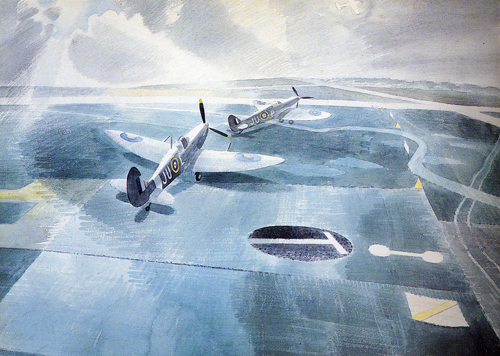camouflage
 Eric Ravilious. Spitfires on a Camouflaged Runway, 1942. watercolour on paper 45 x 62 cm. Royal Air Force Museum, Hendon
Eric Ravilious. Spitfires on a Camouflaged Runway, 1942. watercolour on paper 45 x 62 cm. Royal Air Force Museum, Hendon
Ravilious, above, shows a camouflaged air field, with an added stream, road and shading to indicate topographic variation: complex patterns for a complex landscape. If the RCAF training field in Vulcan had been under threat from the Luftwaffe it would have been painted to look like a wheatfield with rectangular plowing lines.
Aisling O'Carroll wrote about military camouflage in On Site 22: WAR. In her section on deception she outlines the array of dummy trucks, tanks and airstrips elaborately laid out to divert attention from real trucks, tanks and airstrips all cunningly camouflaged with paint, netting and big boxes. She tracked down some great pictures from the National Photographic Archives at Kew – one showing a tank lurking under a very crude truck form as part of the grand counter-installations for el Alamein. The scale of the deception is staggering: an entire army was recreated in a part of the desert far away from the real army.
Camouflage does not seem to be as much about veracity as pattern recognition. The scale worked at is the texture of the landscape with objects, including shadows. It is an activity at once huge and intimate.
